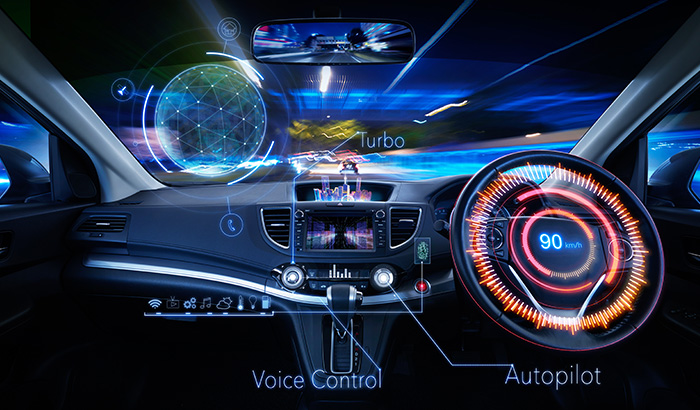Advanced Driver Assistance Systems have become a cornerstone of road safety services in an ever-changing technological environment.
ADAS systems use a variety of sensors and technologies to assist drivers by lowering the chance of accidents and improving auto safety. Advanced Driver Assistance Systems (ADAS) are rapidly becoming essential to auto welfare.
Continue reading to learn how Advanced Driver Assistance Systems have become an invisible hero in modern automobile advancements.
Brief overview of ADAS
Using technology to aid drivers is not a novel concept. It’s been around for decades, and advancements like Anti-lock Braking Systems (ABS) and Electronic Stability Control (ESC) have paved the way for the complex systems we see today.
ADAS has evolved greatly from basic parking sensors to complicated networks of devices working together to handle the intricate dance of modern traffic. Modern ADAS features include adaptive cruise control, blind spot warning, lane assist systems, driver attention monitors, collision warning and braking, auto glass safety detectors, and more.
How does ADAS work?
Automobile manufacturers have recently produced new car models that include ADAS technology in their original designs. The technique employs numerous types of data inputs to create safety measures. These features protect the driver and aid them while driving.
Automotive imaging, for example, employs high-quality sensors that outperform the human eye in terms of 360-degree coverage, good visibility in adverse weather and lighting circumstances, and 3D object resolution. These sensors work together to create various ADAS features.
Benefits of ADAS
ADAS has significantly reduced the number of vehicle collisions on the road. It’s primarily intended to improve driving safety and make journeys more comfortable. Let’s explore its numerous advantages:
Built-in Co-pilot:
The ADAS system primarily functions as a co-pilot, alerting and notifying the driver of potential road hazards and guiding them to drive safely using several technological features.
Adaptable Features:
ADAS adaptable features, such as adaptive cruise control, automated lighting, and pedestrian accident-avoidance mitigation, alert drivers to harm. They do this by providing navigational indications such as lane departures, cars in blind areas, and traffic jams.
Improved Safety Measures:
Improvements to safety measures such as auto glass safety detectors encourage safe driving. ADAS is intended to help drivers avoid crashes on the road by deploying technologies that alert them to possible hazards.
What Does ADAS Do?
We’ve looked at the basic history of ADAS, how the system works, and the benefits of the ADAS system. Next, let’s look at some actual applications of this innovative system.
Adaptive Cruise Control:
Adaptive cruise control is especially useful on the highway, where drivers often struggle to keep track of their speed for extended periods. Advanced cruise control will automatically accelerate, slow down, or even stop the car depending on the actions of other cars or objects in the area.
Automatic Parking:
Automatic parking alerts drivers to the surrounding area, allowing them to know when to turn the steering wheel and come to a complete stop. Rearview cameras provide a greater view of the surroundings than typical side mirrors. Some systems merge the data of several sensors and can even finish parking without the driver’s assistance.
Crosswind Stabilization:
This relatively new ADAS feature assists the vehicle in dealing with high crosswinds. These ADAS sensors detect high pressures acting on the vehicle and apply brakes to the wheels impacted by crosswinds. This allows drivers to operate their vehicles more steadily and safely during a windstorm.
Drowsy Driver Detection:
Driver drowsiness detection notifies drivers when they are sleepy or distracted on the road. There are various methods to tell if a driver’s concentration is waning. In one scenario, sensors can assess the driver’s head movement and pulse rate to see whether they suggest sleepiness. Other systems send driving alerts such as, “It’s time to take a break.”
Automatic Emergency Braking:
Automatic emergency braking employs sensors to assess whether the driver is about to collide with another vehicle or object. This program also detects adjacent vehicles and warns drivers of potential hazards. Cutting-edge emergency braking systems can even perform preventative safety steps like tightening seat belts, slowing down, and activating adaptive steering.
Glare-free high beam and pixel light
Glare-free high beams and pixel light employ sensors to adapt to dark surroundings without disturbing approaching motorists. This innovative headlight program detects other cars’ lights and redirects the vehicle’s lights away from other road users, preventing them from being briefly blinded.
Autonomous valet parking
Autonomous valet parking is a novel technology that manages automobiles in parking lots using vehicle sensor meshing, 5G network connection, and cloud services. Sensors educate the car on where it is, where it needs to go, and how to get there safely. All this data is scrutinized and used to conduct acceleration, braking, and steering until the vehicle is safely parked.
Why is ADAS important?
According to the National Highway Traffic Safety Administration’s (NHTSA) August 2016 Traffic Safety Facts Research Note, “the nation lost 35,092 people in crashes on U.S. roadways during 2015.” This 7.2% gain was described as “the largest percentage increase in nearly 50 years.” An examination indicated that around 94% of those incidents were caused by human error, and the rest by the environment and mechanical faults.
The potential to prevent automobile accidents makes ADAS even more important. Many advanced driver assistance systems applications exist to aid drivers with safety-critical functions, decreasing automobile accidents. These functions include emergency braking, pedestrian detection, surround view, parking assist, driver fatigue detection, and gaze detection.
Can an Accident Affect My ADAS?
If your automobile has an Advanced Driver Assistance System, you should think about how a car collision can damage its function. Damage to your car and ADAS system may be severe depending on the gravity of the collision.
Auto glass safety concerns are a common reason for ADAS failure. The sensors in ADAS are calibrated using specific areas of your windshield. When the glass is cracked or chipped, it often interferes with how the sensors react.
If impact sensors or other system components are damaged or misaligned, they may not function properly. This might result in a possible hazard in the automobile, such as your ADAS system’s failure to identify objects or deliver warnings and alarms when needed. That is why recalibrating your ADAS system after a collision is critical.
Four ADAS Benefits That Go Beyond Safety
ADAS is an amazing system that has changed driver safety but has other benefits too! Let’s dive into some of the other benefits aside from road safety services.
Fuel Efficiency:
ADAS technologies are critical in maximizing fuel economy, which results in cost savings and a lower environmental effect. Adaptive cruise control, which automatically changes the vehicle’s speed based on traffic circumstances, aids in maintaining a steady and efficient driving pace while reducing excessive acceleration and braking.
Drivers can be guided by advanced navigation systems and route optimization algorithms to choose the most fuel-efficient routes. In turn, this will also lower mileage and optimize fuel usage.
Insurance Benefits:
ADAS systems can result in considerable insurance advantages and cost savings for car owners. Because of the demonstrated safety benefits of ADAS technologies, insurance companies may give lower premiums for vehicles equipped with them. Forward collision warning and lane-keeping assistance are two examples of common deductions.
ADAS technologies help lower the number of overall accidents and reduce the severity of incidents that occur. This leads to fewer insurance claims and cheaper costs for both insurers and car owners.
Accessibility:
ADAS technology has helped improve accessibility and diversity in the transportation industry. Individuals with impairments or restricted mobility will benefit from technologies such as adaptive cruise control and automatic emergency braking, which improve their ability to drive safely and independently.
Human Error:
One of the most important advantages of ADAS is its capacity to avoid accidents and reduce the impact of human mistakes. Forward collision warning, blind spot identification, and automated emergency braking operate as an extra pair of eyes for drivers, assisting them in avoiding potential crashes.
Driver drowsiness detection and lane-keeping assistance systems monitor driver behavior and activate to prevent accidents caused by inattention or sleepiness. ADAS systems save lives, prevent injuries, and reduce property damage by drastically lowering the likelihood of accidents and near misses for all road users.
Cons of ADAS:
We’ve talked about the many benefits of ADAS and road safety services, but, like any technological advances, potential problems exist. ADAS makes incorrect decisions at times. For example, it might detect that a car in the adjacent lane on an on-ramp is approaching it. Sensors also struggle to identify tiny or fast-moving objects.
Bad weather might also throw off ADAS sensors. They can be greatly impacted by dirt, snow, fog, rain, or other forms of inclement weather and throw out misinformed alerts.
Another point to consider is that certain ADAS features are futile if drivers ignore them. On the other hand, many people who use technology grow overly reliant on it and, as a result, are more easily distracted.
Excessive repair and calibration expenses are another potential downside of Advanced Driver Assistance Systems. Calibration can cost up to $600 and repairs can run as high as $5,000. These heft price tags sometimes deter car owners from purchasing an ADAS-equipped vehicle.
What’s to Come?
Advanced Driver Assistance Systems are a significant advancement in vehicle safety and technology. Every vehicle that leaves the production line with these complex technologies reweaves the fabric of vehicular travel into a tapestry that emphasizes human life, efficiency, and environmental concern.
As we embrace ADAS, we must also accept its responsibilities. Manufacturers must continually enhance their systems, politicians must adopt educated rules, insurance must understand the importance of ADAS, and drivers must adapt their driving habits.
The potential for safer roads is enormous, and as we move closer to that goal, ADAS will be the compass that guarantees we are moving safely.
Looking for an ADAS Windshield? Utah Mobile Auto Glass can Help!
Windshield cracks can appear at any time, jeopardizing the performance of your vehicle’s Advanced Driver Assistance Systems. It is critical to replace a cracked windshield as soon as possible to retain vision and avoid accidents. ADAS recalibration after replacement is a key step.
The experts at Utah Mobile Auto Glass take pride in our distinguished reputation. We work hard to ensure your vehicle repair goes smoothly. We operate out of Sandy, Utah, and provide excellent ADAS windshield services throughout Salt Lake and Utah counties, including the Bountiful region.
Choosing our services ensures excellent customer service and complete transparency from beginning to end. Contact Utah Mobile Auto Glass immediately, and we’ll get you back on the road safely in no time.
toto slot







